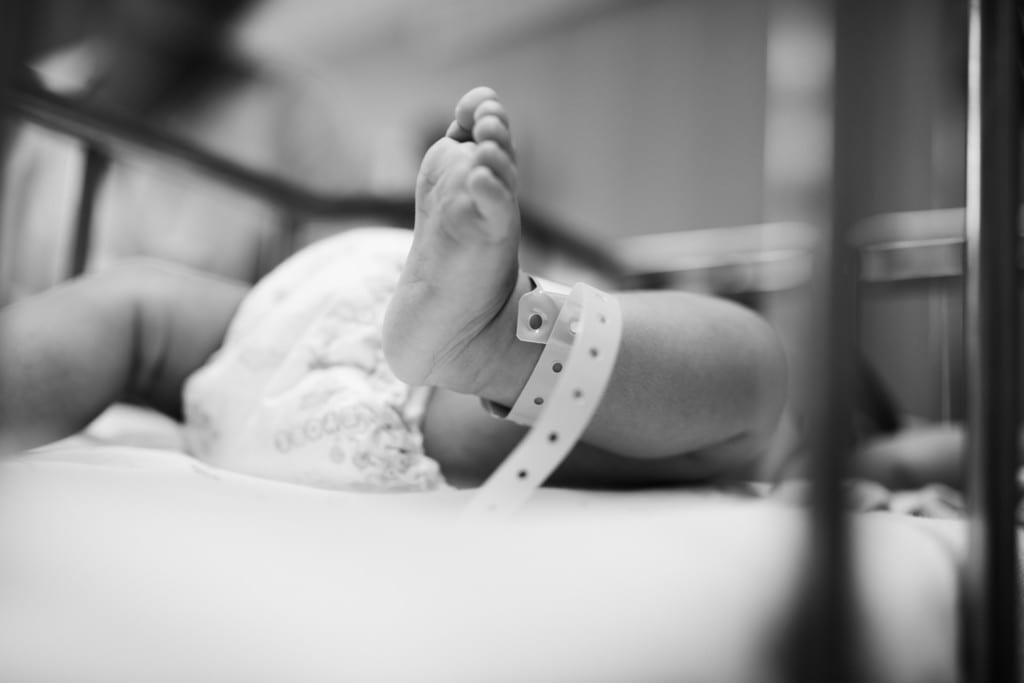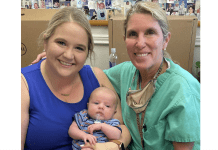I come from a family who makes beautiful, smart children by the tons. We are Irish Catholic, and man, do we like to make those stereotypes about not having a television ring with (at least a little bit of) truth.
The women are strong, loving mothers, with ample amounts of advice to spare. They have each birthed several children, under various circumstances, and together, they are a wealth of knowledge. As the first of my generation to have children, I leaned on them heavily during my first pregnancy.
When I told my momma about my “dream” birth scenario, she did what any mother would do, and gently tried to set reality in for me. I wanted a natural birth, no epidural, no unnecessary interferences. She kindly reminded me there was nothing wrong with needing pain medication, and at the end of the day, “healthy baby, healthy mom” is what mattered. I replied with “I know, Momma,” but her words didn’t sit right with me.
Healthy Baby, Healthy Mom
Whenever I would talk to my aunts or grandmothers about my goals, they would echo my mother: “Healthy baby, healthy mom!” Sure they gave me plenty of other amazing advice, but those words–I hated them. I could not stand being told my dream of an all-natural birth was far-fetched. Instead of feeling supported, I felt like my ignorance was constantly being pointed out, without any type of hope given in return.
But, I put those insecure feelings away, and told myself they were right. They had to be right.These phenomenal women have given birth, collectively, to twenty-four children. Who was I to doubt the “healthy baby, healthy mom” mantra?
And then, it happened. My water spontaneously broke without contractions–you know, like in movies, the way that Lamaze class instructor said it wouldn’t. All over my bed, all over the floor, everywhere.
It Wasn’t Supposed to Happen This Way
Upon arrival at the hospital, they told me I was contracting, but they were not “productive” contractions. So I was given Pitocin, despite telling the nurse I did not want to have it. She informed me it was “standard procedure,” and I could wait for the doctor, but he would tell me the same thing.
So I gave in, and thought to myself, “who am I to question her? I’ve never done this before. She delivers babies all day, every day.”
I refused an epidural, but no one warned me that Pitocin would make the contractions unbearable. They simply said, “tell us if you change your mind.”
After seventeen hours of induced labor, at seven centimeters dilated, I begged for the epidural. I was blacking in and out. I was drenched in sweat. I couldn’t breathe.
An angel of nurse, Julie, came in and held me while the anesthesiologist placed the epidural. He was rude, unkind, and warned me multiple times to “stop shaking or you’ll be paralyzed.” How about you endure induced labor for seventeen hours and then try to sit still, buddy? Julie held my head against her chest and hummed to me, doing her best to block out his angry words.
Julie fought for me. She called my doctor numerous times and convinced him to let me keep trying. She kept other nurses out of my room (at my request). She helped me labor in unorthodox positions, encouraging me like no other. I will never forget her.
But on the twenty-fifth hour, at nine centimeters dilated, my cervix began to swell shut. I spiked a fever, caused by infection from my waters being broken for so long. My baby’s heart rate dropped.
My doctor calmly asked me if I was okay with a c-section. I sobbed, telling him I was absolutely terrified of surgery, but I wasn’t going to risk losing my baby. He very quietly said, “Cailin, it’s time. I can’t let you keep doing this.”
Life or Death
Looking back, the nurses were already prepping me for surgery while he “asked” my permission. This was not a “we are all tired of you laboring” situation. This was a life or death situation.
I could not stop shaking on the operating table. My arms were literally jumping up and down, making an obnoxious sound that echoed in the sterile room. I apologized profusely for it, but my voice was shaking just as much as my body. I clenched my fists in an attempt to control myself, but it was no use. They had to strap me down, for safety purposes.
My husband wasn’t even in the room yet when they started cutting me open. I was asking for him over and over again, but all they could tell me was he was on his way, and this baby had to come out. I sobbed as I felt every single pull and tug. The anesthesiologist kept saying “you shouldn’t be feeling any of that!” as if it were my fault I was in so much pain.
When my husband finally got to my side, our baby was about to be delivered. She didn’t come out screaming. All I heard was “cord around the neck.” Then, nothing.
“WHAT IS WRONG?!” I screamed from the table, and then I finally heard her cry. A sweet, beautiful noise I was so afraid I wouldn’t hear. The doctor announced, “It’s a girl!”
 It’s a Girl!
It’s a Girl!
We named her Genevieve Therese. I didn’t get to hold her. They showed me her face, and took her away.
About an hour later, I finally got to meet my baby. I held her in the tiny recovery room, my sweet momma gently rubbing Genevieve’s head while I encouraged her to latch. Genevieve was so swollen from such a lengthy labor, but I didn’t recognize that at the time. I thought she was just a chunky baby, perfect and round.
And then, after about only thirty minutes of holding her, the on-call pediatrician came in and said some of her numbers were concerning, and they needed to bring her back to the nursery for a bit. I asked for how long, and if I should be worried, and they told me “she’ll be back within the hour, we just want to see where her sugars are.”
Three hours later, I still didn’t have my baby. I was sobbing to my husband to please, please get her back to our room. We had called numerous times to check on her, only to be told she hadn’t been seen yet, but they had her warm under an incubator.
I became angry. I threatened to walk down the hall, fresh stitches and all, and take my child if my husband didn’t do it. He conceded, and nearly four hours after her birth, Genevieve and I finally got to have skin-to-skin and uninterrupted nursing. And her sugar levels were just fine.
Alive But Not Healthy
All of this lead to four months of severe postpartum anxiety, post traumatic stress, and a non-functioning thyroid. Evie was alive, I was alive, but I was not healthy.
I had visions of Genevieve dying, regardless if I was asleep or awake. I could not let her leave my sight. If she was held too long by someone else, I would have a panic attack. I thought she would suffocate in the middle of the night, and I would wake up and find her cold. I cried nearly all day, every day.
But I thought all of this was my own doing. I thought it was my fault for having unrealistic expectations–if I had just listened to everyone and let go of the whole “natural” thing, this wouldn’t hurt so badly. I had set myself up for failure.
Even after getting my thyroid under control, experimenting with therapy, and deepening my prayer life, I could not shake the feeling that my lack of self-confidence played a large part in how Genevieve’s birth went.
This Time It Would Be Different
So, when Evie was nearly eight months old and the smell of crawfish suddenly made me gag, I already knew what I was going to do differently this time.
I would listen to no one but myself, and my husband.
I arrived at my doctor’s office, research in hand, and asked how he felt about a vaginal birth after cesarean (VBAC). His first reaction was “absolutely not. I very, very rarely do those.”
“How many is very rarely?” I asked.
“A handful.”
We sat quietly for a minute. He then told me how since it had only been eight months since Genevieve’s birth, it would only be sixteen months of “healing” for my uterus before it had to endure another labor. I felt defeated, but said I would consider his words. He agreed to revisit the topic at our next appointment.
I discussed my goal of a successful VBAC with my family and was met with immediate opposition. I was told it was unnecessary to put myself and my baby in danger simply to experience a vaginal birth. Women have multiple c-sections all of the time, why do I insist on being any different? Why take a chance when we know multiple c-sections are usually just fine?
I felt myself feeling the same way I did while pregnant with Evie. I felt unsure, worried I was making a mistake, wondering why I thought I knew better than more experienced mothers.
But they didn’t understand the reason I so desperately wanted a VBAC. I wanted to heal. I wanted a chance to prove to myself that my body was not broken. I also wanted to be able to have multiple children in the healthiest way possible, and with each c-section, the risks for placenta previa and placenta accreta increase greatly.
I prayed. I prayed my rosary nearly every night of my second pregnancy. I sought Mother Mary’s guidance and begged her to please help me make the right decision–even if that meant another surgery.
The Goal :: a VBAC
My aunt, a labor and delivery nurse, did not like the idea of a VBAC. However, she encouraged me to research more than I already had, and to have the courage to be direct with my doctor. I will always thank her for that. She may not have liked my goal at first, but she did not stand in my way. She taught me how to be my own advocate in the realm of healthcare.
So, at my next appointment, I did not ask my doctor about a VBAC. I demanded one, and told him if he wasn’t willing to let me try, I would find a doctor who would. I did not say this as a threat (he had plenty of patients), but as a fact. I wanted him to understand how serious I was about at least trying for a vaginal birth.
My research included articles from the American College of Obstetricians and Gynecologists (ACOG) and the American Pregnancy Association, both which state a VBAC poses less risk to mother and child than a repeat c-section. The chance of uterine rupture is less than one percent.
And when you think about it, why would repeating major abdominal surgery be “safer” than a vaginal birth?
My doctor agreed to let me try, under the condition I would immediately accept an epidural upon hospital admittance. This was, God forbid, in case I was one of the fewer-than-one-percent and required emergency surgery again. I agreed.
This Time WAS Different
I went into labor on my own, without my water breaking dramatically, one week before my due date. I got to actually feel real, natural contractions–not induced ones. I stayed awake until two in the morning timing them before I woke my husband and told him it was time to go.
When we arrived, the nurses did not know what to do with me. The moment they looked at my charts and I informed them that no, I would not be having a repeat cesarean, their faces gave away their shock. You’re doing what?!
I had to assure multiple nurses and on-call doctors, multiple times, that I was not joking and I had already planned this with my OB/GYN. My poor doctor had received so many “just checking” calls that he came in to check on me earlier than anticipated, just to stop the questioning.
This time, when I was offered Pitocin, I refused until I discussed it with my doctor. I didn’t care about the nurse’s insistence. This time, I asked for an epidural as soon as possible. This time, I did not entertain “standard procedure.” Instead, I demanded to be heard.
The nurse told me I was nowhere near ready to push. Although I had never pushed before, I told her she was wrong. Mother Mary had heard my prayers, and gave me the strength to trust myself, to trust my body.
I looked at my husband, in tears, terrified I would end up in surgery a second time. He sweetly reminded me of my tattoo, “I am not afraid, I was born to do this.” The words of Saint Joan of Arc.
I told the nurse it was time and I was pushing. She hurried to get my doctor, but I was already holding my husband’s hand and pushing with every pain. My doctor rushed in, a huge smile on his face, and helped us bring our second baby girl in to the world: Josephine Mae.
In an instant, the horrors of Genevieve’s birth disappeared. Josie was placed directly on my skin, not taken from me. She nursed immediately. They didn’t even weigh or measure her for nearly three hours after her birth. She wasn’t swollen with fluid and medication. She never left my room.
I asked the nurse if I could keep feeding her, or if I had to hand Josie over for shots and blood sticks. She looked at me quizzically and said, in the most gentle way, “You can do whatever you want. She’s perfect.”
This time “healthy baby, healthy mom” is exactly what happened.
A VBAC is not about an award. It is not about defying odds for the sake of it.
It is about healing. Not only your body, but your mind, your heart, and your spirit.
We are women, and we are mothers.
Do not be afraid; we were born to do this.
About Cailin
Cailin is a stay at home mom and an attorney. She is married to her husband Andy, and they have two daughters. She is the oldest of seven children and loves to write, read, and spend time with her family.

















Thank you so much for sharing your story. I’m not even pregnant with my second yet and have already been met with the same opposition you have about VBACs. May your story bring courage and strength to those who needed to hear it!